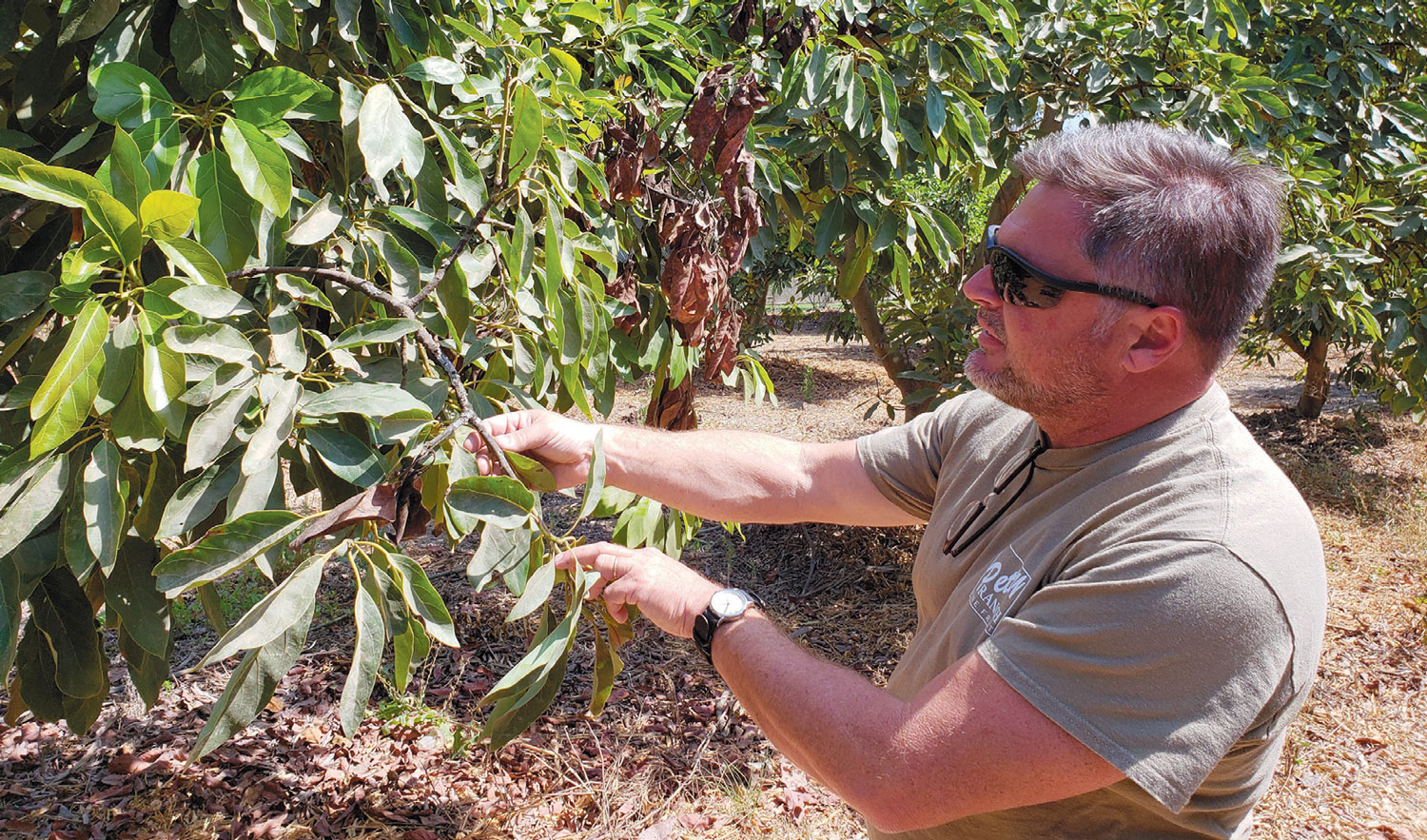Climate Change or Climate Challenge?
Local growers and ag experts weigh in
Is climate change impacting agriculture in Ventura County?
“Yes, but ...” say the farmers, ranchers, water agency representatives and scientists I talked to about climate change in Ventura County. Growers and ranchers proceeded to talk about the harrowing drought and the devastating Thomas Fire, though many of those interviewed pointed out that these could be examples of weather, not long-term climate changes. They also mentioned the extreme two-day July heat wave that damaged avocado groves throughout the county.
Yet after detailing the damages they suffered, farmers and ranchers without exception stressed to me that they remain committed to their work with the land, and expressed confidence about the future of agriculture in Ventura County.
Debbie Brokaw Jackson, who with her family manages a large avocado farm on the outskirts of Santa Paula, says that although the question of how much climate change contributed to the setbacks suffered on her land this year is “very subjective,” she does believe it was a factor.
“I’ll tell you, we had six good years, years of plenty, when the avocado prices were good, the production was good and now we’re getting hit with one thing after another,” she says. “We lost 75 acres of trees and 80% of our crop for both 2018 and 2019 [due to the Thomas Fire], and then the heat wave came and we lost pretty much the rest. Avocados do not like that kind of heat. But on the other hand, it’s exciting to have to rethink our operation, and the way we work.”
For the second year in a row in 2017 agricultural production in Ventura County fell, a drop of almost 4.5% since 2015, to $2,099,889,000, according to the Agricultural Commissioner. That drop is almost half of the expected overall drop in agricultural production statewide due to climate factors, projected to be as much as 10% by 2050, according to the fourth climate assessment released last August by the California Natural Resources Agency. And it does not include the initial damage estimates to ranches and orchards due to the Thomas Fire, estimated at $170 million.
Lead author of the assessment Josué Medellín-Azuara of UC Merced stresses the potential for adaptation in our state.
“Agriculture in California is very dynamic and innovative,” he points out. “We grow more than 300 different kinds of crops here, and many of them are high-value crops [including almonds and avocados] that don’t grow well in other states. Although there will be declines in some commodities, and we are concerned about the prospects for dairy cattle and beef cattle operations, we think that with new technologies and new crop varieties that are more drought resistant we can partially compensate for crop-yield declines due to warmer temperatures and scarcer water.”
DROUGHT HITS CATTLE OPERATIONS
Matthew Shapero, the county’s livestock and range advisor for the UC Cooperative Extension, says the drought that began in 2012 in the county limited the growth of the untended pasture plants on which their cattle have long depended, forcing ranchers to either reduce their herds or supplement their grazing with hay.
“The industry has been severely impacted by drought,” he says. “You can define ‘drought’ in different ways, but precipitation has been significantly below average for six of the past seven years, and even the last two years, which provided some drought relief statewide, have not really benefited Ventura County all that much.”
Shapero says it now takes about twice as much acreage to support a cow as in the past. “The ‘stocking rate’ in Ventura County has changed since the drought,” he says. “Ranchers say that they used to run a cow on 20 acres, but are now running 40 acres per cow, and at this point, after a long protracted drought, even if we get a couple of wet years, it’s going to take a while to build the herds back up.”
WATER WAYS
In reporting on drought, flood and climate issues in Ventura County over the past 20 years, it’s become clear to me that there are no easy answers to the questions raised by the drought this decade in the Ojai watershed. As the largest water user, agriculture—and the way of life that goes with it—has the most at stake.
In a nutshell, Southern California is supplied in large part by water from Northern California via the State Water Project. But Ojai and parts of western Ventura County—a large agricultural producer, with over 68,000 residents—is entirely dependent on local rainfall and groundwater. The rainfall is stored in Lake Casitas, which over the course of the drought has fallen to just over 30% of capacity, a historic low.
That’s alarming to everyone.
The seemingly inexorable decline of the lake has thrown the Casitas Municipal Water District, which was constructed in response to a severe drought in the 1950s, into flux. In 2018, the water district experienced big changes in its top administration and board due to retirements, departures and the November election.
In 2016, in a break from its past tradition of local self-sufficiency, Casitas began discussing with three other county water districts a plan to bring state water to the western side of the city of Ventura, which Casitas has long supplied. This so-called “in lieu” water would allow Casitas to retain a sizeable, if not enormous, amount of water in the lake, estimated by the retired General Manager Steve Wickstrum to be about 3,500 acre-feet annually. The cost to do so is estimated to be about $45 million. More ambitious plans to bring state water directly to Casitas and the Ojai Valley have been proposed by outside water experts, despite legal, bureaucratic and infrastructure obstacles and cost estimates of up to $150 million.
John Krist, CEO of the Farm Bureau in Ventura County, doubts that any plan will bring much state water to Ojai agriculture.
“I’m pretty pessimistic about the chances of additional state water making much of a difference in the relatively dire situation in the west county,” he says. He explains that although Casitas has for years paid for the right to an allocation of 5,000 acre-feet a year of water from the state, on average the state fulfills less than 60% of the allocation for water districts, meaning that the amount of water available to Casitas would probably be less than 3,000 acre-feet a year. That number could fall to zero in a statewide drought, as happened during the drought in 2014.
“Going forward, it’s likely that average will decrease, not increase,” he adds. “The [State Water Project] wasn’t designed to work in an era that produces minimal snowfall but huge pulses of winter rain and snow runoff.”
A UCLA study in 2018 projected a 64% reduction in springtime Sierra runoff by the end of the century, due to reductions in the Sierra snowpack.
Ventura County Supervisor Steve Bennett, whose district includes Ojai and western Ventura, agrees that state water is not reliable, and will become less reliable and more expensive due to climate change and other factors this century. Still, he thinks it’s necessary in the Ojai area as an alternative while a more reliable source—such as desalinated water—is developed.
“We should not hook up to state water from a reliability perspective, but for redundancy,” he says. “If Lake Casitas goes dry, the Valley is in trouble. If you only have one source of water, then any kind of redundancy is worth a lot. Ask the people in Cape Town, South Africa, when they were going dry, if they would be willing to pay for a source of water, no matter how unreliable.”
Rainfall in the Ventura River watershed where Casitas sits has fallen so far short of its historical average since the drought began in 2012 that local farmers are questioning the concept of “normal” rainfall.
“We’ve always had droughts in Ojai, but now we’ll have 10 or 15 years of very dry weather, and then a year or two of really wet weather,” says Jim Churchill, a leading tangerine grower in Ojai. “So the ‘average annual’ rainfall figure turns out not to be useful information.”
Researchers have reached similar conclusions. For Sean Anderson, PhD., chair of the Environmental Science and Resource Management Program at California State University, Channel Islands, what climate change means is a less predictable and more extreme climate. The “universal characterization” among scientists is that the weather—and especially the rainfall—in Southern California is becoming “much more noisy,” Anderson says, with drier, hotter droughts and wetter, more devastating floods.
“We just went through the largest drought in the recorded history of California,” Anderson notes. “The entire state was in drought, but we in Ventura County never fully came out of it.”
Anderson adds that with rising temperatures—which also means more evaporation from the oceans, and more total moisture in the global atmosphere—we now have a better chance of “massive torrential downpours: too much water too quickly.”
As the lake level falls, Casitas has imposed drought restrictions, limiting water to residential landscapes and reducing allocations to agriculture. Ojai growers have responded by cutting demand by more than 40% since the start of the drought, according to Jim Word, a member of the Casitas board.
For Mike Sullivan, a ranch manager, water conservation is part of a “belt-tightening strategy” that he has seen among growers around the county since the drought began in 2012. In the orchards he oversees, he works to reduce water demand by taking out marginal trees and mulching heavily to retain soil moisture.
“We’re feeling the impact of climate change right now,” Sullivan says. “I’m not a scientist but I believe the overwhelming number of climate scientists who say that these events [such as the drought] are going to become more frequent and more intense.”
HOT STUFF
Sullivan recorded temperatures of 117° in Ojai in the searing two-day July heat wave. Chris Sayer, a fifth-generation farmer who grows avocados, lemons and figs, saw temperatures reach 111° in Saticoy, the highest temperature he’s ever recorded. Showing me around his avocado orchard, he points out young fruiting branches scorched and blackened by the heat.
“I see this summer [2018] as a stress test,” Sayer says. His trees in Saticoy survived the heat, but another avocado orchard he oversees a few miles inland with hotter temperatures was badly damaged. He calls the scorching there “ugly.”
“We will probably remove most of that orchard,” he says. “Probably we will replant with avocados, but I admit I’m anxious about it.”
Ben Faber, the lead UC Cooperative Extension crop advisor in Ventura County, agrees, saying that this was the most damaging heat wave in his 30 years of experience in the county. “We went from a low of 56° to a high of 120° in 24 hours,” he says. “For the plants, that acted exactly like the fire. We’ve had high temperatures before, but in the past they ramped up over a few days, and didn’t go to such an extreme heat, giving the plants a chance to hydrate. This was like shoving them into the oven.”
He points out the high temperatures damaged not only subtropical plants such as avocados, but even native trees such as oaks: an alarming sign of the extremity of the temperatures.
In the future, those high temperatures will become more common and more extreme, according to projections calculated for us by Benjamin Hatchett, PhD., a climate scientist at the widely respected Desert Research Institute, working on a grant for the Watersheds Coalition of Ventura County.
Consulting with an expert at the California Avocado Commission, Hatchett learned that temperatures higher than 95° stress and can damage or kill avocado trees. Historically, Hatchett says, farmers in the Ojai and the Fillmore areas could expect to see temperatures in excess of that mark about 30 and 15 days a year on average, respectively.
Estimates using downscaled global climate models predict that these two areas could have up to a seven-fold increase in the number of these very hot days for the late 21st century. “To be fair,” says Hatchett, “these are very preliminary results from this ongoing Ventura County study and show a worst-case scenario, but the increase is certainly concerning.”
Faber notes that with rising temperatures in summer due to global warming comes a reduction in the risk of frost in winter. He points out that growers are now planting lemons and avocados well east of Santa Paula, which 50 years ago likely meant frost damage.
Faber adds that agriculture in Ventura County today looks vastly different than it did in the past. “We were the largest sugar beet producer in the world in 1880,” he points out. “We were the largest lima bean producer prior to World War I. We were the largest walnut producer in the world up until the 1950s. So we have a very adaptable agriculture. We might not recognize what agriculture looked like in the past, and we may not recognize what it looks like in the future.”
Case in point: Jackson, the avocado grower in the Santa Paula area, says, “We’re thinking of diversifying our crops—maybe planting more lemons, which did a little better with the fire. And we’re looking into the possibility of mangos.”








